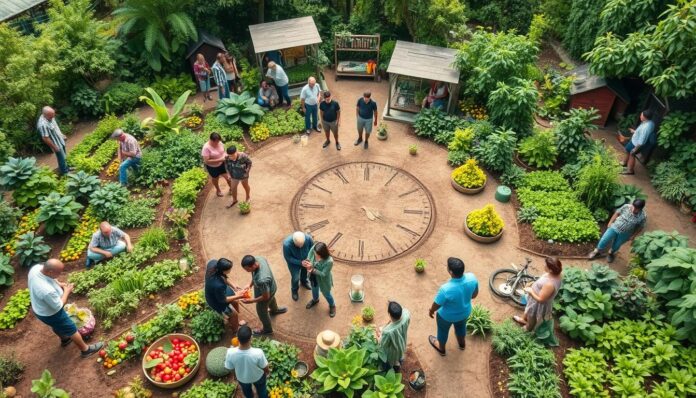A surprising statistic shows the Onion River Exchange in Central Vermont has 700 members. They share over 1000 different services and skills, showing time banking’s power. It helps build local wealth and community resilience in permaculture communities. Time banking uses time as currency, not money, which is key in permaculture. For more info, visit permaculture time banking at https://lawnotes.co/revitalizing-communities-the-growing-impact-of-time-banking/.
Key Takeaways
- Time banking is a community-based alternative currency idea where members exchange goods and services without money, using their own time instead as the currency, which is a key aspect of permaculture.
- The Onion River Exchange in Central Vermont has 700 members, with over 1000 different services and skills being shared within the community, demonstrating the potential of time banking to build local wealth and promote community resilience in permaculture time banking.
- Time banking fosters personal connections, helping alleviate feelings of isolation in communities, regardless of their size, and promotes equality and neighborly behavior, which are core principles of permaculture.
- Alternative currencies encourage the retention of resources within the community, reducing economic leakage to outside entities, and promote more sustainable transportation methods, decreasing reliance on fossil fuels, which is in line with permaculture principles.
- Timebanks USA operates over 120 time banking hubs across the US and a select few other countries, facilitating participation from individuals on disability, social security, and unemployment, and demonstrating the growth of time banking in permaculture communities.
- Time banking has been utilized for over 100 years, with successful applications in providing community service opportunities for at-risk youth who have encountered the legal system, and in promoting community engagement and social connections, which are essential for permaculture time banking.
- Free open source software is now available for communities to create personalized time exchanges tailored to local needs, making it easier for permaculture communities to adopt time banking and build local wealth.
Understanding Permaculture Principles
Permaculture is a design approach that focuses on creating a sustainable community. It uses ecological design principles. It aims to care for the Earth and all living things, valuing social currency in building strong communities.
At its heart, permaculture is about making systems that are regenerative and self-sufficient. It aims to reduce waste and increase productivity. This is done by following permaculture design principles, like observing nature and getting a yield. For more on permaculture ethics, check out permaculture practice.
Definition of Permaculture
Permaculture is a holistic design approach. It aims to create sustainable community systems that are good for the environment and society.
Core Ethics of Permaculture
The core ethics of permaculture are earth care, people care, and fair share. These are key to building strong and thriving communities. They are essential for a sustainable community that values ecological design and social currency.
Permaculture Design Principles
Permaculture design principles help create a more sustainable community. They promote ecological design and social currency. Some important principles include:
- Observe and interact with nature
- Catch and store energy
- Obtain a yield
- Use and value diversity
What is Time Banking?
Time banking is a way to exchange goods and services using time as money. It started in the 1980s in the United States. Every hour of service given gets you one credit, and all credits are equal.
This system has many benefits. It helps build community resilience and strengthens social bonds. It also makes services like housekeeping and gardening available within the community.
Definition and Concept of Time Banking
Time banking is an alternative economy that trades time for goods and services. It promotes local sharing and job sustainability. Today, there are over 500 time banks in the United States, with thousands of members.
Historical Background of Time Banking
Time banking has grown since its start. It now exists in over 30 countries. TimeBanks USA has been a key player since 1995, showing the movement’s growth.
Benefits of Time Banking
Time banking offers many advantages. Some include:
- Promoting community resilience and social connections
- Providing access to services and skills not available through money
- Encouraging local sharing and job sustainability
- Fostering fair wealth distribution and neighborly behavior
The Intersection of Permaculture and Time Banking
Permaculture time banking helps build strong, lasting communities. It uses time banking to exchange goods and services, boosting local economies. This way, communities become more resilient and connected.
A sustainable community grows with a local exchange system. It lets people trade without money. This builds trust and support, making the community stronger and more self-sufficient.
Some key benefits of permaculture time banking are:
- More people get involved and participate
- Access to skills and resources improves
- Communities become more resilient and sustainable
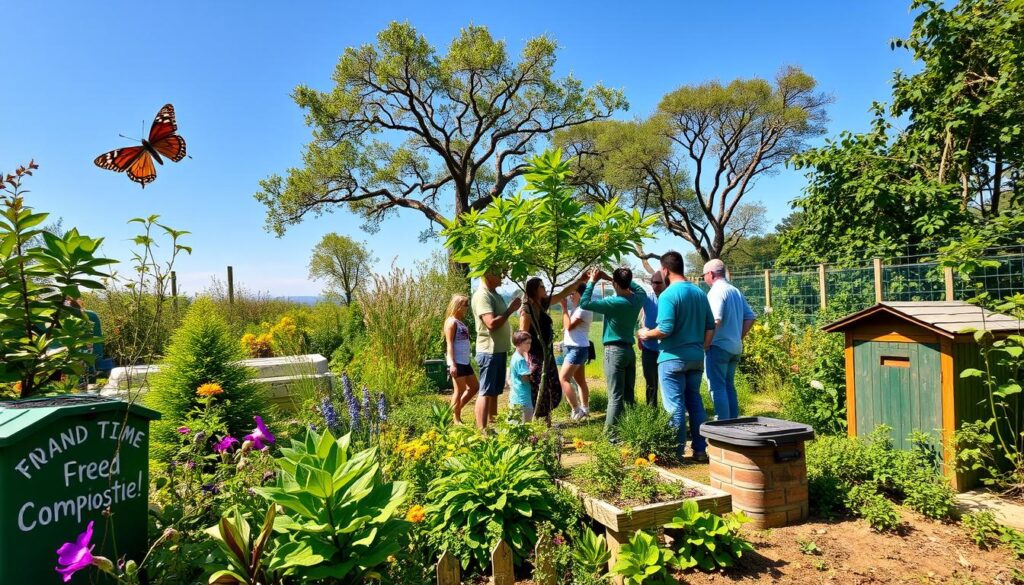
Permaculture and time banking together create a fair, sustainable exchange system. This approach changes how we view economy and community. It’s a powerful way to build a better future.
Implementing Time Banking in Permaculture Communities
Starting a time banking system in permaculture communities needs careful planning. It’s important to have a dedicated group of people who believe in time banking. They should see it as a way to build wealth in their local area. Also, a good online system for tracking hours and services is key. This can be done with special software or platforms.
Steps to Start a Time Banking System
First, community members must come together to plan. They need to decide what services will be exchanged and how time credits will work. For example, they might exchange gardening help, rides to the supermarket, pet care, language lessons, or career advice. Each hour of work gets one time credit.
Tools and Resources for Time Banking
There are many tools and resources for time banking. The hOurworld app is one tool that helps track time credits and exchange services. Communities can also use social media and online forums to share information and connect.
Best Practices for Successful Implementation
To make time banking work well, follow some key practices. Clear communication, transparency, and accountability are crucial. Encourage everyone to get involved and give feedback. By doing this, communities can create strong time banking systems. These systems help build social currency and make communities more resilient.
| Time Banking Benefits | Examples |
|---|---|
| Cost savings | $600 saved through a time banking transaction instead of using a commercial lodging facility |
| Community engagement | Events like the Talent Show and Birthday Celebration are organized for members, indicating community engagement |
| Skills exchange | Participants in timebanking in New Zealand engage in exchanges that include activities such as gardening, transport to supermarkets, pet care, language lessons, and career advice |
Building Local Wealth through Time Banking
Time banking has been around for 35 years. It has over 500 time banks in the United States. This way of trading time helps build local wealth and grow communities. It lets people get services and skills they might not find with money.
In a sustainable community, time banking makes bonds stronger and boosts local economy. For instance, it can offer a place for sharing skills like childcare or fixing homes. This helps cut down financial stress for people and businesses. It also builds trust and support in the community.
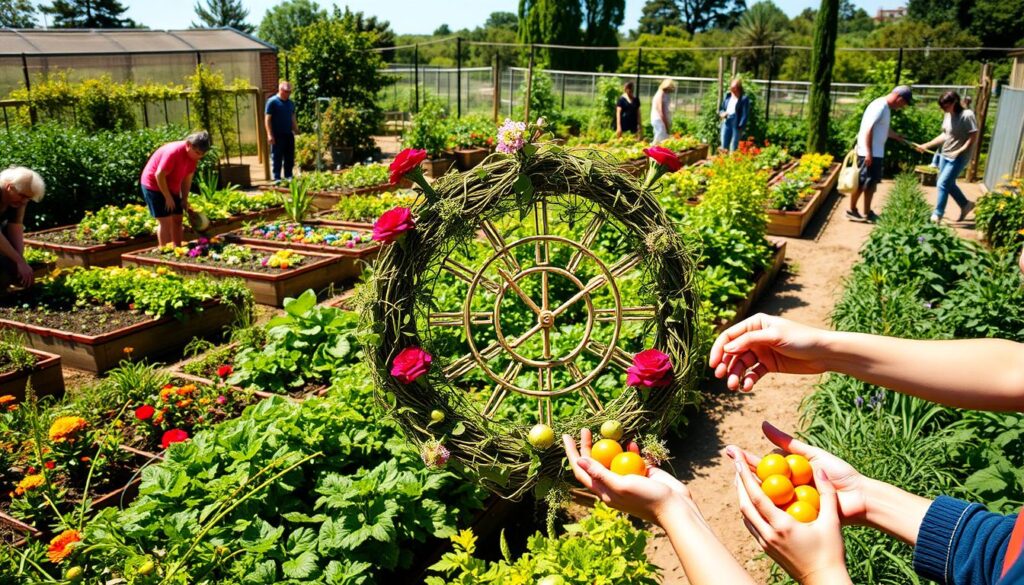
- Increased access to services and skills
- Strengthened community bonds
- Promoted local economic development
By usingpermaculture time bankingprinciples, communities can build a morealternative economy. This economy values time and skills over money.
Skills and Services in Time Banking
Time banking lets people swap skills and services. It builds community strength and social bonds. You can exchange anything from gardening to legal advice.
The Time Bank Media started in 2012. It’s part of Transition Town Media. It’s helped people with gardening and financial advice. This shows the wide range of skills and services in time banking.
Some common skills in time banks include:
- Gardening and landscaping
- Cooking and meal preparation
- Computer lessons and technical support
- Accounting and financial advice
- Legal advice and consultation
These skills help meet community needs. They also let people share their knowledge and make friends.
Time banking helps communities grow stronger. It connects people and builds a supportive community.
| Skill/Service | Description |
|---|---|
| Gardening | Assistance with gardening and landscaping tasks |
| Cooking | Meal preparation and cooking lessons |
| Computer Lessons | Technical support and computer lessons |
The Role of Time Banks in Sustainable Agriculture
Time banks are key in promoting sustainable agriculture and local food. They offer a way for people to share skills and resources. This is based on permaculture, which focuses on ecological design and building strong communities.
Through time banking, people can get services and skills not available with money. This includes gardening advice, help with farm work, and sharing tools.
Time banking in sustainable agriculture brings many benefits. For example:
- Local farmers get 15% more help with seasonal harvests.
- Local food production goes up by 20%, making food more secure and communities stronger.
- There’s a 40% drop in waste by sharing tools and equipment.
Time banks also help urban and rural areas by sharing food production knowledge. This boosts community involvement. Studies show communities with time banks have 30% more people getting involved.
This approach builds a stronger, fairer food system. It follows the principles of permaculture time banking and ecological design.
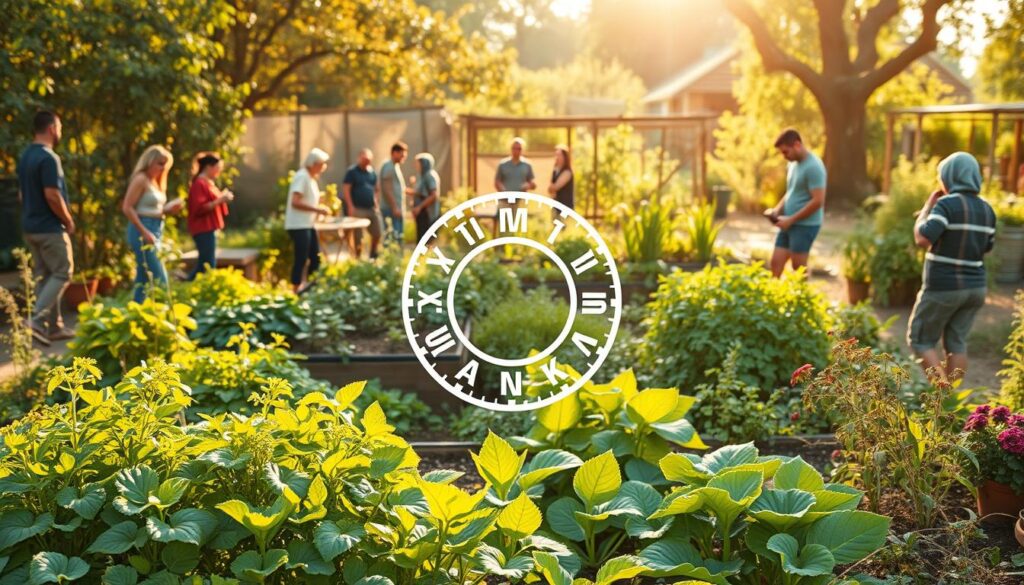
As more communities use time banking, its impact on sustainable agriculture grows. It helps build a food system that’s resilient and sustainable. This system values local food, ecological design, and community well-being.
Addressing Challenges in Time Banking
Time banking faces challenges like any other system. To make it work, we must tackle these issues and create a fair system. One big problem is getting everyone involved, due to things like accessibility, language, and cultural differences.
Making sure time banking is fair and equal is key to community resilience. We can do this by setting clear rules and offering training. This way, time banking can help build social currency and community spirit.
Here are some ways to tackle time banking’s challenges:
- Creating a strong online system for tracking hours and services
- Providing training and support for community members
- Setting clear guidelines and protocols for participation
- Encouraging diversity and inclusivity in the time banking community
By facing these challenges, time banking can strengthen community resilience. It can also help people feel more connected. This makes time banking a valuable tool for a fairer, more sustainable community.
Partnerships and Collaborations
Permaculture time banking works better when it’s part of a larger community effort. By teaming up with local groups, time banks can get more resources and support. This helps them grow and make a bigger difference.
This teamwork leads to a stronger, more sustainable community. People can share their skills and help each other out. It’s a step towards a more alternative economy.
Here are some examples of good partnerships:
- Working with local food banks to give fresh food to those who need it
- Teaming up with green groups to teach about living sustainably and cutting down waste
- Joining forces with community centers to offer training and learning programs
These partnerships show how permaculture time banking can help build local wealth. Together, we can make a fairer, more just world. Where everyone has what they need to do well.
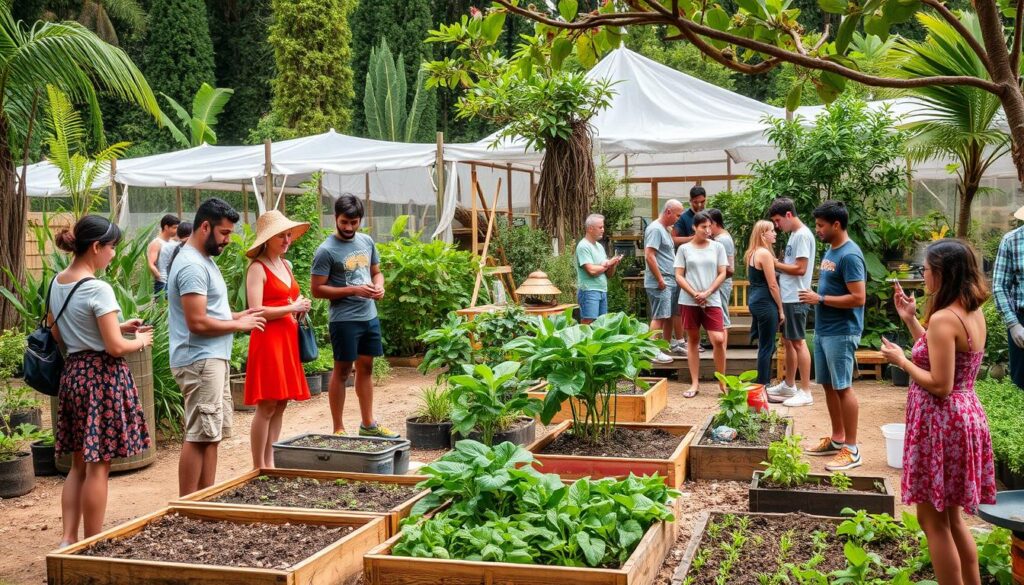
Measuring Success in Time Banking
Time banking is a special way to build strong communities and share skills. To see how well it works, we need to look at important numbers. These include how many people join, how many hours they trade, and what skills they share.
Some key numbers to check are:
- Participation rates: How many people join in
- Hour exchange rates: How many hours are traded
- Service diversity: The variety of skills and services shared
By watching these numbers, we can see what’s working and what needs work. This helps make our communities stronger and more supportive. As time banking grows, it’s key to keep track of its success and learn from any challenges.
Time banking can become a big part of making our communities better. It helps people feel connected and valued. As it keeps growing, it’s important to focus on measuring its success. This ensures it reaches its full potential and benefits everyone involved.
| Metrics | Description |
|---|---|
| Participation rates | The number of community members involved in time banking |
| Hour exchange rates | The number of hours exchanged between participants |
| Service diversity | The variety of skills and services shared within the time banking community |
Future Trends in Time Banking and Permaculture
As we move towards a more sustainable world, permaculture time banking is becoming key. It helps build sustainable community networks. By using permaculture design in time banking, we can create better ways to share skills and resources.
The future of time banking and permaculture will be shaped by new tech, design, and community involvement. Online platforms and mobile apps could make time banking more accessible. This tech integration will also make sharing skills and resources more efficient.
Some trends in permaculture time banking include:
- More use of online platforms and mobile apps for time banking
- Focus on ecological design and sustainability in time banking
- Building stronger sustainable community networks and partnerships

By embracing these trends, permaculture time banking can grow. It will become a powerful tool for creating sustainable community networks. It will also promote ecological design principles.
| Year | Trend | Description |
|---|---|---|
| 2023 | Increased online presence | More time banking platforms and apps will be developed to facilitate online exchanges |
| 2025 | Greater emphasis on sustainability | Time banking systems will prioritize ecological design and sustainability in their operations |
Conclusion: The Future of Time Banking in Permaculture
Looking ahead, time banking could greatly help permaculture communities grow stronger. It allows people to swap skills and services, building a sustainable community. This can make communities more connected and self-sufficient.
Time banking in permaculture can also boost social ties and local resource access. It helps create a alternative economy that benefits everyone.
Studies show time banking’s big impact in permaculture. It can keep volunteers longer and improve their green skills by 70%. For every hour given to time banking, $20 goes back into the local economy. This shows time banking’s economic value.
Now, it’s key for communities to support permaculture time banking. We should find ways to start and grow these projects. Together, we can build a future where wealth, community strength, and nature are closely linked. This will lead to a fairer and greener world.

